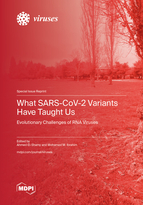What SARS-CoV-2 Variants Have Taught Us: Evolutionary Challenges of RNA Viruses
A special issue of Viruses (ISSN 1999-4915). This special issue belongs to the section "SARS-CoV-2 and COVID-19".
Deadline for manuscript submissions: closed (30 December 2022) | Viewed by 74218
Special Issue Editors
Interests: viral hepatitis; DAA; liver cancer; novel therapies; lipid metabolism; emerging infections
Special Issues, Collections and Topics in MDPI journals
Special Issue Information
Dear Colleagues,
RNA viruses have a rapid pace of evolutionary change. Mutations in RNA viral genomes occur at a pace that greatly exceeds that observed in other organisms and determine much of their evolutionary “behavior”. For instance, RNA viruses have a great ability to cross species barriers and, hence, emerging new human and animal viruses. Indeed, emerging RNA viruses are currently the biggest health threat to humankind to emerge in a very long time. Thus, it is crucial at this time to shed some light on how the evolutionary behavior of RNA viruses shapes their epidemiolocal, fitness, and pathological features. This will contribute toward a better understanding of how to deal with these threats.
Dr. Ahmed Elshamy
Prof. Dr. Mohamed M. Ibrahim
Guest Editors
Manuscript Submission Information
Manuscripts should be submitted online at www.mdpi.com by registering and logging in to this website. Once you are registered, click here to go to the submission form. Manuscripts can be submitted until the deadline. All submissions that pass pre-check are peer-reviewed. Accepted papers will be published continuously in the journal (as soon as accepted) and will be listed together on the special issue website. Research articles, review articles as well as short communications are invited. For planned papers, a title and short abstract (about 100 words) can be sent to the Editorial Office for announcement on this website.
Submitted manuscripts should not have been published previously, nor be under consideration for publication elsewhere (except conference proceedings papers). All manuscripts are thoroughly refereed through a single-blind peer-review process. A guide for authors and other relevant information for submission of manuscripts is available on the Instructions for Authors page. Viruses is an international peer-reviewed open access monthly journal published by MDPI.
Please visit the Instructions for Authors page before submitting a manuscript. The Article Processing Charge (APC) for publication in this open access journal is 2600 CHF (Swiss Francs). Submitted papers should be well formatted and use good English. Authors may use MDPI's English editing service prior to publication or during author revisions.
Keywords
- RNA virus
- mutations
- emerging viruses
- coronaviruses







